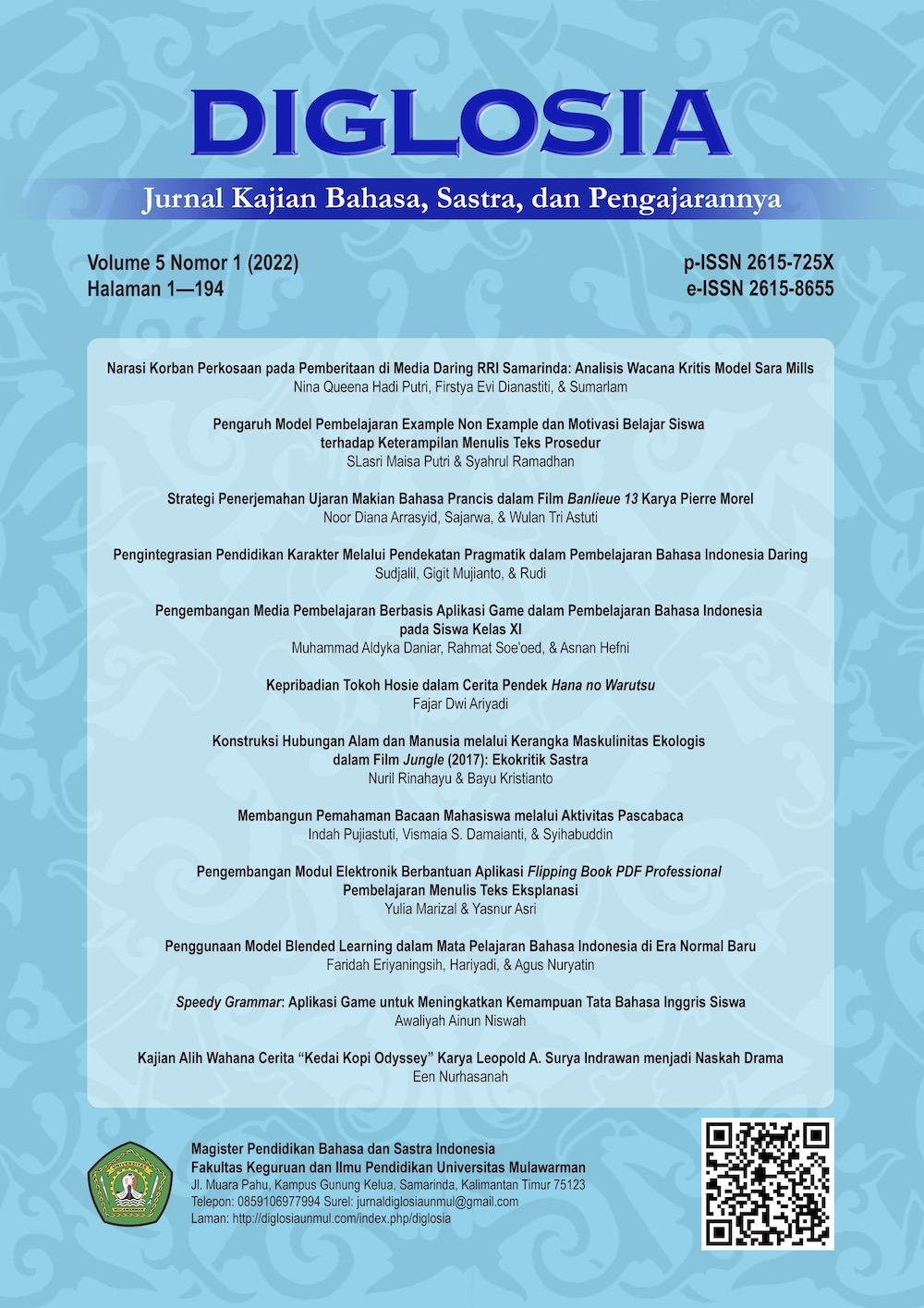Strategi Penerjemahan Ujaran Makian Bahasa Prancis dalam Film Banlieue 13 Karya Pierre Morel Translation strategy of French-language profanity in Banlieue 13 film by Pierre Morel
Main Article Content
Abstract
This study aims to identify the strategies through which French-language profanity is translated into Indonesian by using a corpus of data drawn from the dialogues of the French film Banlieue 13 and its Indonesian subtitles. The data were collected through certain steps started with watching the film, noting each use of French-language profanity and its Indonesian translation, then classifying those data based on Davoodi's proposed categories of profanity translation strategies. This study finds that four strategies were used for translating French profanity to Indonesian: censorship (as in the term 'bordel', which was left untranslated), substitution (as in the term 'putain', translated as 'astaga'), taboo (as in the term 'merde', translated as 'sial'), and also euphemism (as in the term 'merde', translated as 'hal buruk'). Furthermore, the result shows that both French and Indonesian language profanity is often used in reference to situations and occupations considered taboo in society.
Downloads
Article Details
![]()
Every work in Diglosia: Jurnal Kajian Bahasa, Sastra, dan Pengajarannya is licensed under a Creative Commons Attribution-ShareAlike 4.0 International License.
Under the following terms:
- Attribution — You must give appropriate credit , provide a link to the license, and indicate if changes were made . You may do so in any reasonable manner, but not in any way that suggests the licensor endorses you or your use.
- ShareAlike — If you remix, transform, or build upon the material, you must distribute your contributions under the same license as the original.
- No additional restrictions — You may not apply legal terms or technological measures that legally restrict others from doing anything the license permits.
Authors who publish with this journal agree to the following terms:
- Authors retain copyright and grant the journal right of first publication with the work simultaneously licensed under a CC BY-SA 4.0 DEED Attribution-ShareAlike 4.0 Internationalthat allows others to share the work with an acknowledgment of the work's authorship and initial publication in this journal.
- Authors are able to enter into separate, additional contractual arrangements for the non-exclusive distribution of the journal's published version of the work (e.g., post it to an institutional repository or publish it in a book), with an acknowledgment of its initial publication in this journal.
- Authors are permitted and encouraged to post their work online (e.g., in institutional repositories or on their website) prior to and during the submission process, as it can lead to productive exchanges, as well as earlier and greater citation of published work.
References
Anggraini, D., & Himmawati, D. R. (2017). Translation Equivalence of Swearwords in The Walking Dead Comic. Language Horizon, 5(1), 100–108. Retrieved from https://jurnalmahasiswa.unesa.ac.id/index.php/language-horizon/article/view/20699
Anindya, W. D. (2018). Keakuratan dan Keterbacaan Terjemahan Onomatope, Ungkapan Makian, dan Ungkapan Budaya dalam Novel The Maze Runner ke dalam Bahasa Indonesia (Tesis, Universitas Gadjah Mada). Universitas Gadjah Mada, Yogyakarta. Retrieved from http://etd.repository.ugm.ac.id/home/detail_pencarian/154607
Arifin, W., & Soemargono, F. (2001). Kamus Prancis Indonesia. In Kamus Prancis Indonesia. Jakarta: Gramedia.
Arifin-Partiningrat, W., Labrousse, P., & Sumargono, F. (2001). Kamus Perancis-Indonesia. Jakarta: Gramedia Pustaka Utama.
Catford, J. C. (1965). A linguistic theory of translation. London: Oxford University Press.
Davoodi, Z. (2009). On the Translation of the Taboos. Retrieved August 14, 2020, from TranslationDirectory.com website: https://www.translationdirectory.com/articles/article2052.php
Departemen Pendidikan Nasional. (2008). Kamus Besar Bahasa Indonesia. Jakarta: Pusat Bahasa. (Jakarta).
Éncyclopédie Larousse. (2000). Larousse.fr: Encyclopédie et dictionnaires gratuits en ligne. Retrieved October 4, 2020, from https://www.larousse.fr/
Hadiwijaya, M., Amalyasari, M. R., & Yahmun, Y. (2021). Penggunaan Tindak Tutur Direktif Mahasiswa Multikultural dalam Konteks Kesantunan: Diglosia: Jurnal Kajian Bahasa, Sastra, Dan Pengajarannya, 4(4), 413–424. https://doi.org/10.30872/diglosia.v4i4.230
Hoed, B. H. (2006). Penerjemahan dan kebudayaan. Jakarta: Pustaka Jaya.
Hughes, G. (2006). An encyclopedia of swearing: The social history of oaths, profanity, foul language, and ethnic slurs in the English-speaking world. Armonk: M.E. Sharpe.
Jay, T. (2000). Why we curse: A neuro-psycho-social theory of speech. Amsterdam: John Benjamins.
Jay, T. (2009). The Utility and Ubiquity of Taboo Words. Perspectives on Psychological Science, 4(2), 153–161. https://doi.org/10.1111/j.1745-6924.2009.01115.x
Khalaf, A. S., & Rashid, S. M. (2019). Pragmatic Functions of Swearwords in the Amateur Subtitling of American Crime Drama Movies into Arabic. International Journal of Asia Pacific Studies, 15(1), 97–131. https://doi.org/10.21315/ijaps2019.15.1.4
Krathwohl, D. R., & Anderson, L. W. (2010). Kerangka Landasan Untuk Pembelajaran, Pengajaran, dan Asesmen (Revisi Taksonomi Pendidikan Bloom). Yogyakarta: Pustaka Pelajar.
Newmark, P. (1988). A textbook of translation. New York: Prentice Hall.
Sajarwa. (2017). Deconstructing Equivalence in the Translation of Texts from French to Indonesian. Humaniora, 29(2), 159–167. https://doi.org/10.22146/jh.24063
Sajarwa. (2020). Metode Penelitian Penerjemahan. In Sajarwa (Ed.), Metode Penelitian Bahasa (hal. 111–124). Yogyakarta: Fakultas Ilmu Budaya, Universitas Gadjah Mada.
Scarlet, A. A. S. (2019). Penerjemahan Kala Bahasa Prancis Ke Dalam Bahasa Indonesia Pada Komik Les Aventures De Tintin Karya Georges Remi (Skripsi, Universitas Gadjah Mada). Universitas Gadjah Mada, Yogyakarta. Retrieved from http://etd.repository.ugm.ac.id/penelitian/detail/176536
Udasmoro, W. (2012). Pengembaraan Serat Centhini dalam Les Chants de l’île à Dormir Debout dan Ia yang Memikul Raganya: Interpretasi, Inovasi dan Distorsi dalam Penerjemahan. Sosiohumaniora, 14(1), 52–65. https://doi.org/10.24198/sosiohumaniora.v14i1.5478
Wijana, I. D. P., & Rohmadi, M. (2006). Sosiolinguistik: Kajian Teori dan Analisis. Yogyakarta: Pustaka Pelajar.

